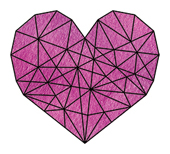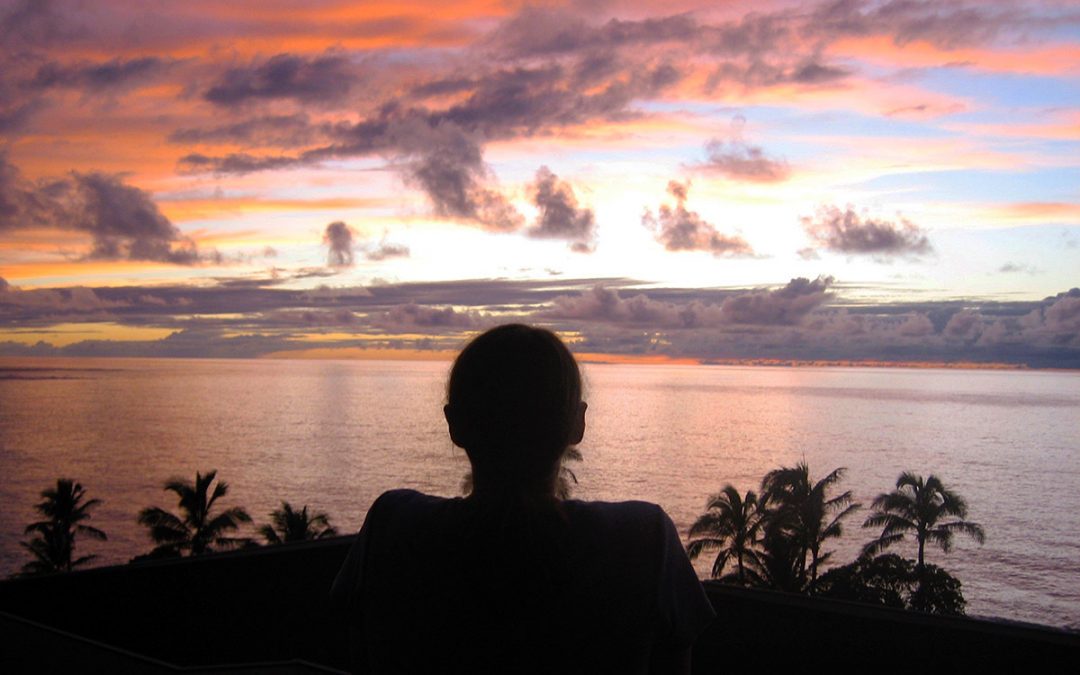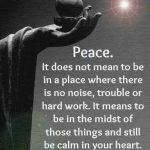When you make the time and the space for what you long to do, the world around you will shift in all sorts of apparently miraculous ways to support the realization of those longings.
— Sarah Susanka, The Not So Big Life
Almost twenty years ago, I wrote an article for Soulfulliving.com about the creation of sacred space and the feeling of home. Ever since that time, I have shared that article on my website to help explain the origins and impetus for writing the nine books in the Not So Big series. At root is the understanding that home is not only a building we live in but also our way of living. Until we begin to look at the content of our lives as a sort of spiritual food, we cannot truly grow beyond the patterns of behavior that keep us stuck and frustrated. (You’ll find a link to a TEDx talk called Life’s Invisible Feast in my bio, which explains what I mean, for those who are interested.) It’s this process of looking at all of life with the eyes of a student that provides the impetus for this post, and for a process that I call “The Year End Review.”
If you have read The Not So Big Life, you’ll know the influence that Normandi Ellis, author of Awakening Osiris and Dreams of Isis, has had upon my life. Twenty-four years ago, Normandi introduced me to the Year End Review process. I wrote about the transformative nature of first meeting her, and then the exercise, in Chapter 11 of The Not So Big Life. (You’ll find a link to the Year End Review exercise, in my bio, as well, for those who want to experience it for themselves.)
Our lives are perfectly crafted to reveal who and what we really are.
All that’s required is our presence.
— Sarah Susanka, The Not So Big Life
Since that time back in 1996, not only have I engaged in the practice each year at year’s end, but countless others who’ve read my book have integrated this practice into their own lives as well. And since 2008, I’ve been offering Year End Review workshops to students of the Not So Big Life at the transition between years, to provide a forum for those interested in sharing the process with other students. (For those interested in coming to a future workshop, you will need to first attend an Introductory Not So Big Life Workshop, which I offer once a year, usually over the Labor Day Weekend. You can read more about this and other workshops on my website.)
This morning, as the week between Christmas and the New Year—the week officially designated for the exercise—is now in full swing, I had a huge desire to look back at past years’ entries in my Year End Review Notebook and to write about what I discovered. My intention was to observe not only my musings from the previous years, but also, what might be revealed about my life from over two decades-worth of entries. Who is this Sarah Susanka character? How does she go about her life? What interests her? What are her hopes and dreams? And how many of them actually come into being?
Express it and let it go
As those of you who’ve engaged in the Year End Review exercise, or who’ve attended one of the Not So Big Life Year End Review workshops, will know, the intent is to look back at the year just passed, to pay attention to what is arising in one’s life in the present, and to cast forth one’s hopes and dreams for the future. But then comes the most important part…to let go of any effort to make those dreams come into being. The point of the exercise is to express the dreams, but not try to make them happen. The only time you give yourself permission to revisit the dreams of past years is during this Year End Review, and that’s when you get to see how many of them have actually started to manifest, without any effort to make them do so on your part.
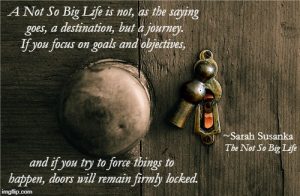
Although this may seem crazy to those who think they are actually the primary agent of their dream implementation, if you become a serious student of the inner work to understand oneself, what you will discover is that, in fact, you never have been in control. And it is only in letting go and allowing life to take you where you need to be taken that the things you’ve been dreaming of actually come into being. It’s a paradox. The part of you that wants to make things happen is actually in the way of your recognizing what is happening. And very often what is happening is the path that will take you to what you are longing for. If you discount the opportunities being placed before you, though, you never actually live along into the realization of those dreams.
So this morning, as I sat with all my years of Year End Review writing, I was looking at the whole process of past years’ happenings, hopes and dreams, to see what could be learned from all of them, as a collection. And the experience of doing so as thoroughly as I just did, reading so many entries from so many moments of transition between years, has been a powerful awakening to the perennial issues of the part that I am playing in this lifetime.
New year, same struggle
Although I’ve written a whole book about the issue of finding meaningfulness in the midst of a too busy life, (The Not So Big Life: Making Room for What Really Matters—the subtitle says it all!) my lifetime struggle has been, and in many ways continues to be, finding time for the things I want to do. Reading year after year of entries, the common thread between years can best be expressed with this question:
How can I make time for writing, sacred geometry explorations, and documenting the teachings I’ve been exposed to, and indeed am now teaching myself?
And at the end of almost every Year End Review, after pages of exploration, wonder and delight at what has presented itself over the past year, in the last few paragraphs the real question finally arises:
What stops me from dropping the idea that I am supposed to be doing something different than I am doing?
This in turn is followed by the understanding that whatever is being engaged with passion and wholeheartedness is the source of the desired meaningfulness that is being pursued so intently. It’s not about identifying the “right” thing to be doing, but rather simply about doing whatever is being engaged in with an open heart, mind and spirit.
I know this of course, but still, each year, there is an experiencing of the apparent obstacles to the implementing of this knowledge. And what I am seeing this morning as I write this piece, is that every year contains elements of this same struggle.
What is your formula?
Here are the steps in sequence. It’s quite literally a formula, a pattern, that gets lived every year:
- The wishing for something to be different than it is;
- The expression of those wishes for difference;
- The recognition that in fact the meaningfulness is right here in every moment, in which I cease splitting myself from the simplicity and perfection of this moment, whatever its content, and however awkward, irritating or upsetting it may seem in appearance.
This is the formula that’s apparent from my own entries. Can you identify your own formula? If you have three or four Year End Reviews to look through, you may be able to spot it for yourself. Yours will be different than mine in all likelihood, and as you summarize your own formula, it can teach you a lot about how you create your own world. It’s not important “what” the formula is, so much as what it tells you about how you create your world, but you have to first see the structuring of the formula in order to grasp its effects on the way your world gets generated.
I can see from my own formula that I live my life looking for the signs that I am accomplishing my objectives, only to realize in moments of clarity that the meaningfulness I’m really looking for—when I drop the notions about what I should really be doing—is right here already! Even though at times there will be all the types of activities I want to be engaged in, it won’t always be the case, and it doesn’t actually matter, because the content of what I’m doing isn’t the point! It’s the wholehearted engagement in whatever is before me that dissolves the wishing for something different. And even though I’ve written a whole book about this understanding, the pattern still plays.
(For those who are serious readers and students of the Not So Big Life, this is a wonderful example of what is meant by the teaching that “the personality doesn’t go away.” It still plays, but without attachment to (which includes disdain for) the patterns of the personality, one can observe it doing its thing, and when it is brought into awareness, one can do something different without struggle. (It’s no longer taking place on automatic.)
Travelers on a path
Ten years ago, in my January 2010 entry, I listed a series of books that I wanted to write. Today, a decade later, my life is now moving into the period of writing that was longed for at that time. The names of the books I want to write now are identical to those I wanted to write back then. If I were to look through a lens of “failure” and “not enough-ness,” I might say that I’ve wasted this whole decade. If I were to look through a lens of “success” and “sufficiency,” I might say that I’ve accomplished what I set out to do, and finally have the time I’ve been working so hard to find.
But when we understand that we are not in control of how things unfold, and are simply travelers on a path for which the road is made by walking, as we walk, those imaginings we’ve longed to experience come up to greet us. They are not always what we think they should be, and they are rarely instantaneous, but when we let go and allow life to present us with the food for our own growth, we see in hindsight a miraculous path in which many, if not all, of the dreams do manifest. We just have to be patient and pay attention.
It is only in looking back over so many years that I see now that almost all of my dreams have indeed come to pass. Just not quite in the form I’d imagined they would. But more perfect than those original imaginings could have envisioned by orders of magnitude.
Once you make the unequivocal internal commitment to do something, the world around you will shift in all sorts of apparently miraculous ways to make it happen.
— Sarah Susanka, The Not So Big Life
Seeing with whole mind
There’s a wonderful quote from Chan Master Wei Wu Wei that seems perfect for this moment: “To split mind, Nirvana is Samsara. To whole mind, Samsara is Nirvana.”
If those terms are unfamiliar to you, we could as easily say, “To split mind (the mind that splits things into opposites), Heaven is Hell. To whole mind (the mind that sees from the point of non-dual awareness), Hell (and everything experienceable) is Heaven.
It is only when we look without dividing our world into “have and have not,” “good and bad,” and “pleasing and frustrating,” that we discover that what we do have is exactly perfect, with not a hair out of place. Learning to see in this way is what we are here for. In our own lives we are able to observe the perfection amidst all the apparently and decidedly imperfect happenings.
And that’s what The Year End Review is really here to help us see as well. Today, at the threshold to a new decade and a new year of existence—one named 20:20, a time of visual acuity if the sight analogy has anything to tell us—perhaps we will each be given the opportunity to see ourselves just as we are, without the filters of hope or judgment that keep us from seeing clearly our real condition.
Peace for the new decade
Whether or not you are able to conduct a version of the Year End Review for yourself, I wish you a view into your internal workings that will help you to see just how miraculous your life really is. We are more fortunate than we normally ever allow ourselves to recognize, no matter how difficult the current circumstances may be.
I’ll close with some wise words that I also included in The Not So Big Life, at the end of Chapter 6, “Learning to See Through the Obstacles:”
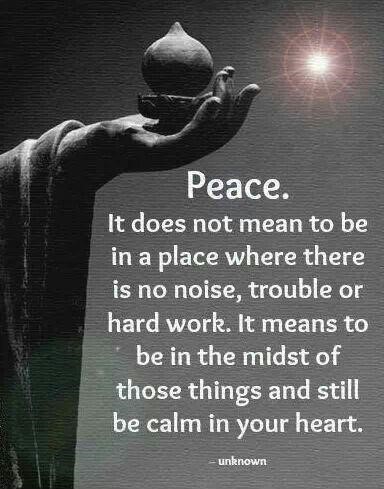
Here at the doorsill between the decades, I wish you this kind of peace, along with the time and space to let yourself look deeply at the gifts of the past year and decade, the present surroundings, and the promise of the future. Thank you for reading, and a spectacular new year and decade to you!
Copyright 2020 Sarah Susanka. All Rights Reserved.
 |
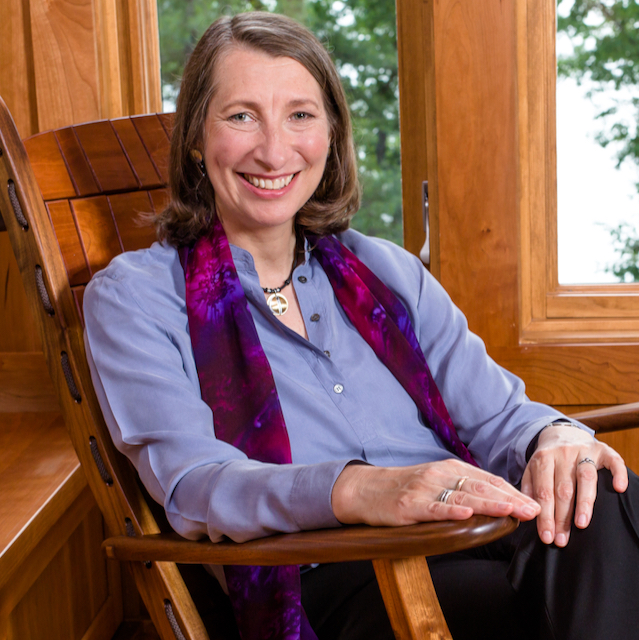
Social innovator, acclaimed architect, agent of personal transformation, and author of the ‘Not So Big’ series, Sarah Susanka has become the inspiration for a new way of understanding how we inhabit both our homes and our lives.
She is the best-selling author of nine books —including The Not So Big House, Home By Design, and The Not So Big Life—that collectively weave together home and life design, teaching us that a ‘Not So Big’ attitude serves not only architectural aims, but life goals as well.
Through her writing, lectures, and workshops, we learn that a rich, full, satisfying life is readily within reach. Susanka explains that it’s how we are in what we do, not the specific content of our lives, that’s important. There’s no need for massive upheavals in everyday life to find meaning. Her credo is simple: When we look with the eyes of a student, everything can teach us more about who and what we truly are—we just have to learn how to look.
Recommended TEDx Talk: Life’s Invisible Feast
Recommended Exercise: Year End Review exercise
